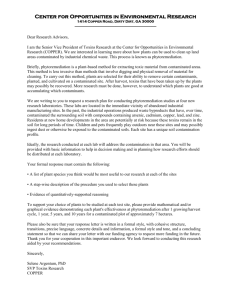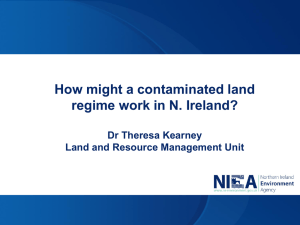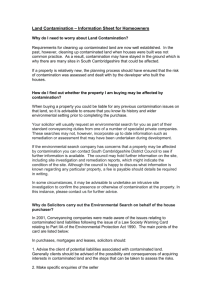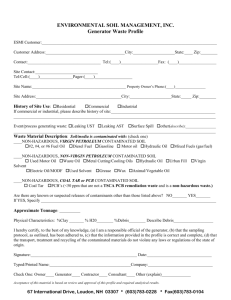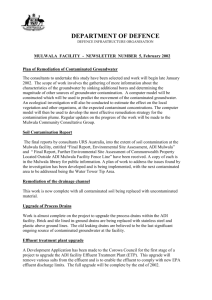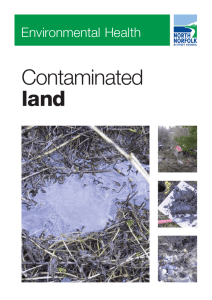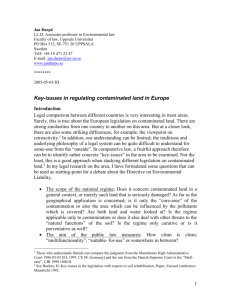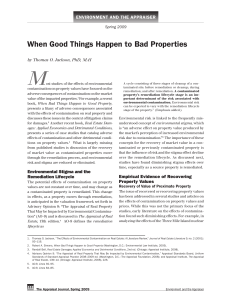policy directive no
advertisement
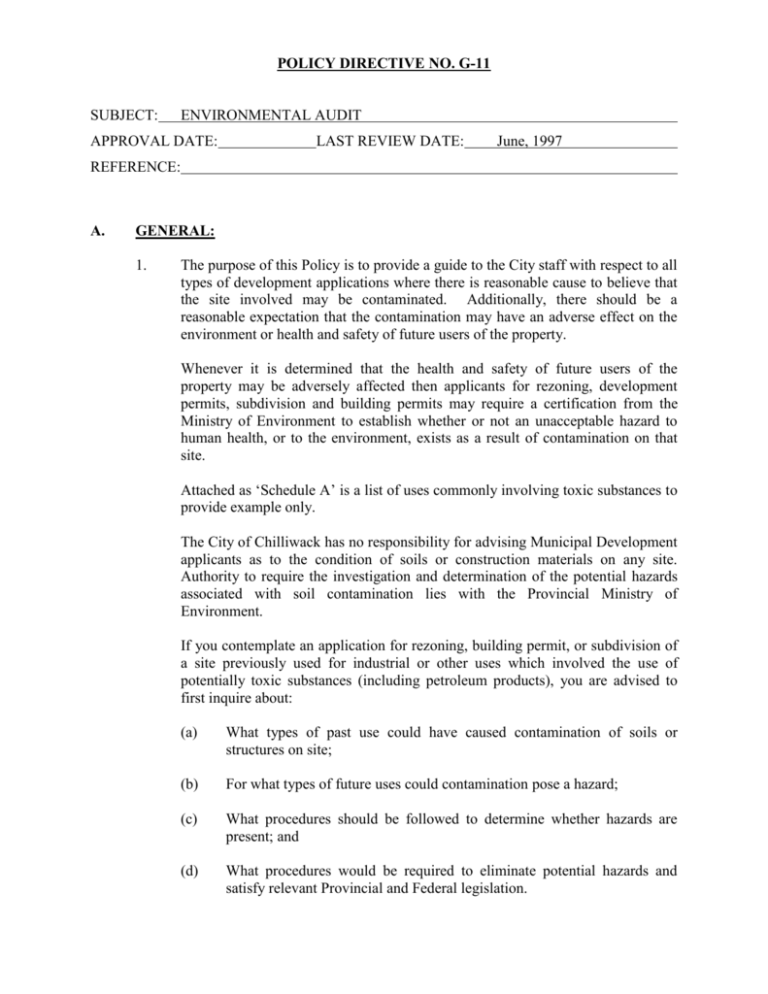
POLICY DIRECTIVE NO. G-11 SUBJECT: ENVIRONMENTAL AUDIT APPROVAL DATE: LAST REVIEW DATE: June, 1997 REFERENCE: A. GENERAL: 1. The purpose of this Policy is to provide a guide to the City staff with respect to all types of development applications where there is reasonable cause to believe that the site involved may be contaminated. Additionally, there should be a reasonable expectation that the contamination may have an adverse effect on the environment or health and safety of future users of the property. Whenever it is determined that the health and safety of future users of the property may be adversely affected then applicants for rezoning, development permits, subdivision and building permits may require a certification from the Ministry of Environment to establish whether or not an unacceptable hazard to human health, or to the environment, exists as a result of contamination on that site. Attached as ‘Schedule A’ is a list of uses commonly involving toxic substances to provide example only. The City of Chilliwack has no responsibility for advising Municipal Development applicants as to the condition of soils or construction materials on any site. Authority to require the investigation and determination of the potential hazards associated with soil contamination lies with the Provincial Ministry of Environment. If you contemplate an application for rezoning, building permit, or subdivision of a site previously used for industrial or other uses which involved the use of potentially toxic substances (including petroleum products), you are advised to first inquire about: (a) What types of past use could have caused contamination of soils or structures on site; (b) For what types of future uses could contamination pose a hazard; (c) What procedures should be followed to determine whether hazards are present; and (d) What procedures would be required to eliminate potential hazards and satisfy relevant Provincial and Federal legislation. Policy Directive No. G-11 ENVIRONMENTAL AUDIT Page 2 of 4 GENERAL (continued) For such information contact: Manager, Environmental Safety Program Waste Management Branch Ministry of Environment 810 Blanshard Street Victoria, British Columbia V8W 2H2 Telephone: (250) 387-4321 2. The preferred approach is to require a suspected contaminated site to be remediated before any rezoning, subdivision or issuance of a building permit occurs. The City may rely upon the Waste Management Branch of the British Columbia Ministry of Environment or consultants retained by the developer or the City. A consultant, who may or may not be an engineer, would only certify that any required soils remediation had in fact been completed. Notwithstanding such certification further soils remediation may be required. Before a development approval is issued, the City may obtain sufficient security to ensure that the planned soil remediation will be completed. In conjunction with the security deposit the City may require an indemnity from the developer under Section 215(2(a) of the Land Title Act. 3. In summary, the City has no direct legislative authority to require that a contaminated site be cleaned up. However, Council can refuse to grant a rezoning if, in their opinion, it would lead to an adverse environmental impact or health hazard. Also, the Approving Officer might refuse to approve a subdivision as being contrary to the public interest if he had a sufficient factual basis which indicated that subdivision of the land would increase public exposure to contaminated soil. A building permit or development permit could be refused based on suspected soil contamination. The most opportune time to require the remediation of a contaminated property is at the rezoning stage. Should a property be suspected of being contaminated at any stage of development then action should be taken immediately to verify the condition of the property with respect to contaminants before further development work commences. In these situations and with each case being somewhat different, staff must discuss an appropriate course of action to be taken. Policy Directive No. G-11 ENVIRONMENTAL AUDIT Page 3 of 4 GENERAL (continued) Each development application involving a property adversely affected by contaminants is likely to have many unique factors to be considered. It shall therefore be the policy of the City to have the Office of Principal Interest (OPI) e.g. Municipal Development Department, consult and co-ordinate the input of all concerned Municipal staff and outside agencies in determining an appropriate course of action. ______________________________ Chief Administrative Officer Policy Directive No. G-11 ENVIRONMENTAL AUDIT Page 4 of 4 SCHEDULE ‘A’ LIST OF ACTIVITIES LIKELY TO CONTAMINATE SOIL To identify lots on which the soil is likely to be contaminated, account must be taken of the type of activity carried on there. The following list includes some examples of activities which warrant special attention. The Elimination of Waste and Other Residues: Sanitary landfill and disposal of dry materials Back-filling using industrial residues Elimination of industrial wastes Snow removal dumps Garbage dumps Disposal of mining residues Industrial and Commercial Activities: Chemical and petrochemical industry Pharmaceutical industry Pesticide industry Paint and lacquer industry Solvent and re-cycling industry Pulp and paper industry Metallurgical industry Electro-technical industry Galvanizing industry Foundries Wood preservation industry Tanneries Navel shipyards Textile industry Coking plant (plant manufacturing artificial gas using coal, tar refining) Fertilizer industry Battery, used oil, liquid waste and barrel re-cycling plants Service stations Dry-cleaners Automobile, bus and subway repair and maintenance workshops Transformer substations (condensers) Storage and Transfer of Hazardous Substances: Storage of chemical and petrochemical products Storage of pesticides Storage of solvents Oil pipeline rights-of-way Scattering: Scattering of contaminated sediments Scattering of petroleum residues Scattering of sludge from water purification plants or septic tanks


